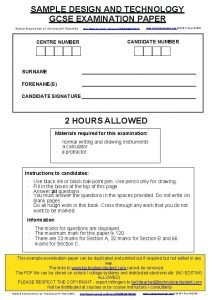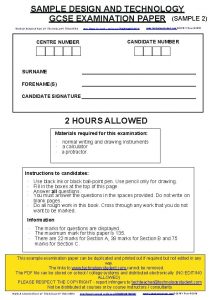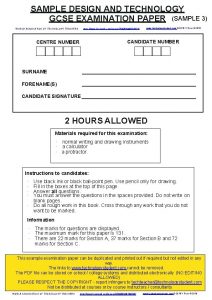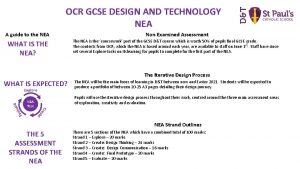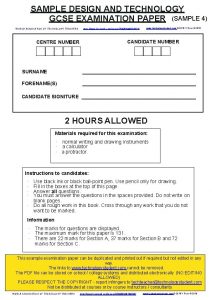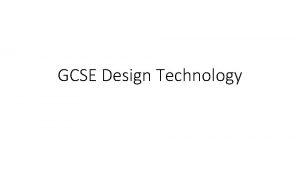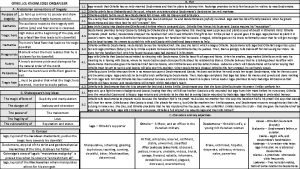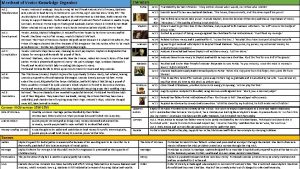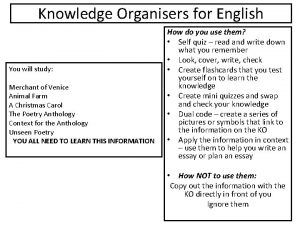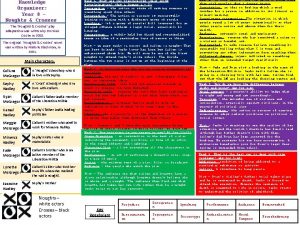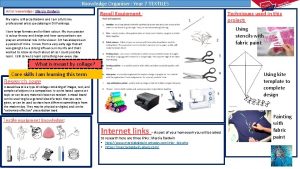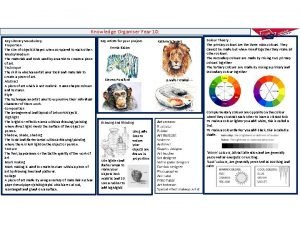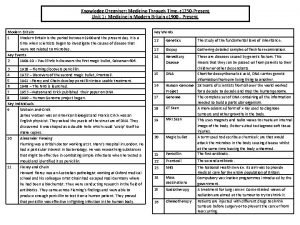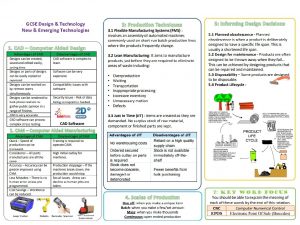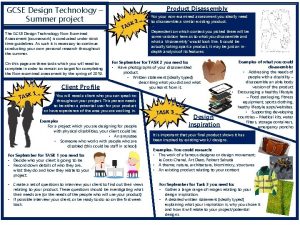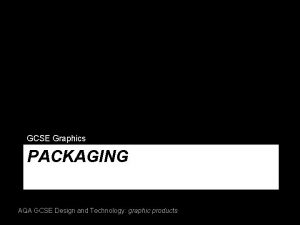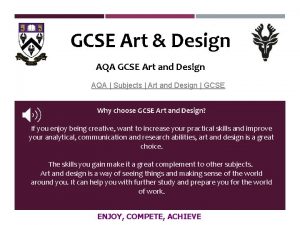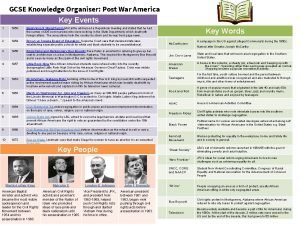GCSE Knowledge Organiser Design Technology Knowledge organiser KS













- Slides: 13

GCSE Knowledge Organiser – Design Technology Knowledge organiser KS 4 GCSE

GCSE Knowledge organiser

GCSE Knowledge organiser

GCSE Knowledge organiser






• The 6 Rs are an important checklist. They are used by designers to reduce the environmental impact of products. They can also be used to evaluate the environmental impact of other products. The hierarchy of sustainability places the strategies that are best for the planet about those that have a greater negative impact on the environment. Not eating (or using) products that are overfarmed, over-fished or on the endangered list. Consumers have a growing number of choices to make about where and on what they spend their income. Greener and more sustainable options are not always the cheapest or the best, but making informed decision and rethinking ones spending power can play a huge part in conserving resources. Deciding on the design of a product, e. g. the materials being used in its production, will directly affect its sustainability. The types of questions designers need to ask are: • • • Are the materials locally sourced? Are they sustainably produced? Is it essential to use this material, of which there is a finite supply? By rethinking how the product is likely to be made, the product can often be redesigned in a more responsible way. The first stage in the process is to ask whether the proposed product, part, purchase or even journey is required at all. Asking the question ‘Is it really necessary? ’ can play a major role in reducing the demand on materials. Simply not using something saves 100% of what you have chosen not to use. Example include: • Using your own carrier bag rather than purchasing a new one. • Walking or cycling to school instead of being driven. Not using products such as some pesticides that are known to be harmful to the environment Our planet has to provide all of our basic human needs, such as food, shelter and warmth. Designers now have a much better understanding of which materials are sustainable and which are not. The general principle is that resources fall into two categories: Finite resources – are ones which are in limited supply or cannot be reproduced. Non-finite resources – are ones which are in abundant supply and are unlikely to be exhausted. Reduction is often the result of having re-thought a design or action. Materials and energy are saved due to efficient manufacturing practices and the use of clever design, incorporating sustainable materials. • • Modern materials that are lighter and stronger than traditional ones have contributed to the miniaturisation of products, saving material and energy in manufacture and use. Reducing the complexity or number of parts a product uses and reducing the number of different materials in a product makes recycling easier. In factories, schools and hotels, fitting motion sensitive lighting and smart heating systems can significantly reduce energy usage. Many large companies employ staff to conduct ‘energy walks’ to turn off unused appliances and lights and to ensure windows and doors are shut to conserve heat. Once all useful and recyclable materials are removed, the majority of the remaining waste is organic matter and can be processed in one of two ways; ‘Recover’ or ‘Rot’. Food waste and garden waste can be processed at a high temperature and turned into compost. The waste can also be buried in landfill sites where the resulting methane gas from the rotting matter is collected and burned and used to generate heat or electricity in the same way. Reusing products multiple times for the same purpose is also known as primary recycling. Reusing a product in a different way from the one it was designed for is known as secondary recycling. The classic glass milk bottle is reused many times before it reaches the end of its useful life, as which point it is recycled. Aplastic milk bottle, however, is intended to be used only one, although it can have many different subsequent uses. Donating to and buying from charity shops extends the life of products and in recent years there has been a resurgence of in products having second lives, thanks to websites such as e. Bay, Freecycle or Gum tree. It is also becoming popular for furniture and other household items to be upcycled with a coat of paint and some minor repairs or adaptations, extending their useful life by many years. Being able to repair a product when it is broken or worn is a way of extending its life and delaying the purchase of a new one. Repairing is a positive option over replacement as it means that only some parts of the product are replaced. This creates jobs for skilled people who conduct repairs and stimulates a spare parts market. Unfortunately, repairing products has become harder over years. Growing number of products are not design to be repaired. There a number of reasons why items may be designed this way, but it is usually because they are cheaper to replace than repair. Some products, especially modern electronic products, are designed to last only a few years as technology dates quickly and older products will be superseded by newer, faster, more efficient models. This is called planned obsolescence. Tertiary recycling, although a very important stage, is lower down the hierarchy of preferred options because most materials that are recycled this way tend to be of lower quality than the original material. It takes a lot of energy to recycle materials. This form of recycling requires the reprocessing of the material and in many cases involves chemicals and/or heat to recover the recycled materials. In an ideal world, tertiary recycling would remove all recyclable materials from our household waste so that only biodegradable materials would be left. Only very few parts of the world are set up to cope with this level of processing.

Designer Name Marcel Breuer Sir Alec Issigonis William Morris Mary Quant Louis Comfort Tiffany Facts Marcel Lajos Breuer (22 May 1902 – 1 July 1981) was a Hungarian-born modernist, architect, and furniture designer. Breuer extended the sculptural vocabulary he had developed in the carpentry shop at the Bauhaus into a personal architecture Sir Alexander Arnold Constantine Issigonis; 18 November 1906 – 2 October 1988) was a British. Greek designer of cars, widely noted for the ground-breaking and influential development of the Mini, launched by the British Motor Corporation (BMC) in 1959. William Morris (24 March 1834 – 3 October 1896) was an English textile designer, poet, novelist, translator, and socialist activist. Associated with the British Arts and Crafts Movement, he was a major contributor to the revival of traditional British textile arts and methods of production. Dame Barbara Mary Quant, Mrs Plunket Greene, (born 11 February 1934) is a Welsh fashion designer and British fashion icon She became an instrumental figure in the 1960 s London-based Mod and youth fashion movements. Louis Comfort Tiffany (February 18, 1848 – January 17, 1933) was an American artist and designer who worked in the decorative arts. He is best known for his work in stained glass. Logo Examples

Designer Name Philippe Starck Facts Philippe Starck (born January 18, . 1949) is a French designer known since the start of his career in the 1980 s for his interior, product, industrial and architectural design including furniture Coco Chanel Gabrielle Bonheur "Coco" Chanel (19 August 1883 – 10 January 1971) was a French fashion designer and businesswoman. She was the founder and namesake of the Chanel brand. Alexander Mc. Queen Lee Alexander Mc. Queen, CBE (17 March 1969 – 11 February 2010), known professionally as Alexander Mc. Queen, was a British fashion designer and couturier. He is known for having worked as chief designer at Givenchy from 1996 to 2001 and for founding his own Alexander Mc. Queen label. Vivienne Westwood Dame Vivienne Isabel Westwood DBERDI (born 8 April 1941) is a British fashion designer and businesswoman, largely responsible for bringing modern punk and new wave fashions into the mainstream. Harry Beck Henry Charles Beck (4 June 1902 – 18 September 1974), known as Harry Beck, was an English technical draughtsman best known for creating the present London Underground Tube map in 1931. Norman Foster Norman Robert Foster, Baron Foster of Thames Bank, OM, Hon. FREng (born 1 June 1935) is a British architect whose company, Foster +Partners, maintains an international design practice famous for hightech architecture. Logo Examples

Designer Name Facts Raymond Templier RAYMOND TEMPLIER (1891 1968) like many of his contemporaries in jewelry, was born to a family with a long tradition as jewelers. Gerrit Thomas Rietveld; 24 June 1888 – 25 June 1964) was a Dutch furniture designer and architect. One of the principal members of the Dutch artistic movement called De Stijl, Rietveld is famous for his Red and Blue Chair. Charles Rennie Mackintosh (7 June 1868 – 10 December 1928) was a Scottish architect, designer, water colourist and artist. His artistic approach had much in common with European Symbolism. His work was influential on European design movements such as Art Nouveau and Secessionism. Aldo Rossi (3 May 1931 – 4 September 1997) was an Italian architect and designer who achieved international recognition in four distinct areas: theory, drawing, architecture and product design. He was the first Italian to receive the Pritzker Prize for architecture. Ettore Sottsass (14 September 1917 – 31 December 2007) was an Italian architect and designer during the 20 th century. His work included furniture, jewellery, glass, lighting, home objects and office machine design, as well as many buildings and interiors. Gerrit Rietveld Charles Rennie Macintosh Aldo Rossi Ettore Sottsass Logo Examples Company Name Facts Alessi is a housewares and kitchen utensil company in Italy, producing everyday items from plastic and metal, created by famous designers. Apple Inc. is an American multinational technology company headquartered in Cupertino, California that designs, develops, and sells consumer electronics, computer software, and online services. Braun Gmb. H formerly Braun AG, is a German consumer products company based in Kronberg. From 1984 until 2007, Braun was a wholly owned subsidiary of The Gillette Company, which had purchased a controlling interest in the company in 1967. Dyson Ltd. is a British technology company established by James Dyson in 1987. It designs and manufactures household appliances such as vacuum cleaners, hand dryers, bladeless fans, heaters and hair dryers. GAP The Gap, Inc. commonly known as Gap Inc. or Gap, (stylized as GAP) is an American worldwide clothing and accessories retailer. Primark Under Armour Zara Primark known as Penneys in the Republic of Ireland) is an Irish clothing and accessories company which is a subsidiary of ABFoods, and is headquartered in Dublin. Under Armour, Inc. is an American company that manufactures footwear, sports and casual apparel. Zara is a Spanish clothing and accessories retailer based in Arteixo, Galicia. It is the main brand of the Inditex group, 3 the world's largest apparel retailer. Logo Examples
 Sample design and technology gcse examination paper answers
Sample design and technology gcse examination paper answers Sample design and technology gcse examination paper answers
Sample design and technology gcse examination paper answers Sample design and technology gcse examination paper answers
Sample design and technology gcse examination paper answers Ocr product design gcse
Ocr product design gcse Technology student
Technology student Gcse design and technology coursework examples 2019
Gcse design and technology coursework examples 2019 Knowledge organiser romeo and juliet
Knowledge organiser romeo and juliet Othello knowledge organiser
Othello knowledge organiser Merchant of venice knowledge organiser
Merchant of venice knowledge organiser Merchant of venice knowledge organiser
Merchant of venice knowledge organiser Noughts and crosses knowledge organiser
Noughts and crosses knowledge organiser Art knowledge organiser
Art knowledge organiser Art knowledge organiser
Art knowledge organiser Medicine through time knowledge organiser
Medicine through time knowledge organiser
